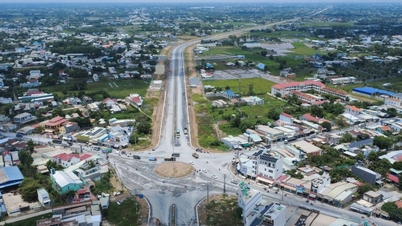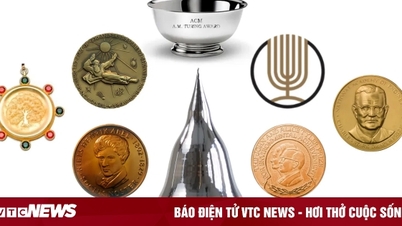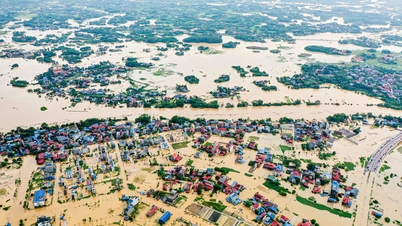“For nearly 40 years in the profession, the dream of Vietnam having an international maritime center has always burned in me,” Mr. Pham Quoc Long, Deputy General Director of Gemadept Joint Stock Company, Chairman of the Vietnam Maritime Agents, Brokers and Services Association (VISABA) shared at a meeting of leading enterprises in the fields of logistics, infrastructure and energy.
“The time is ripe” for Vietnam to break through
According to Mr. Pham Quoc Long, never before has Vietnam had so many favorable conditions as it does now to realize the dream of becoming an international maritime center.
Geopolitical competition between major countries is changing the global trade map, broken supply chains are forcing logistics corporations to find new transit points - and Vietnam is emerging as a "golden link" of the Indo- Pacific economic corridor.
In particular, the merger of Ho Chi Minh City with Ba Ria - Vung Tau and Binh Duong to form a "super city" of 18 million people, accounting for 24% of the country's GDP, further strengthens the position of the southern region in the global transport - logistics chain.

Many representatives of businesses and associations expressed their opinions and suggestions at the meeting. (Photo: Organizing Committee)
Vietnam currently has the second largest container cargo output in ASEAN with 30 million TEU/year, a growth rate of 21%, just behind Singapore. However, the paradox is that we still have a logistics trade deficit, when most of the support services are still held by foreign enterprises.
Although it has entered the group of the most vibrant container shipping markets in the region, Vietnam is still " playing at home with the rules set by others".
Mr. Pham Quoc Long pointed out that domestic enterprises only hold about 20% of the supply chain, mainly in charge of loading and unloading, and small-scale operations. The system of seaports and warehouses is still scattered, fragmented, lacking regional connectivity and synchronous infrastructure.
A typical example is the Cai Mep - Thi Vai port cluster: Although it has the natural advantage of being deep, wide, and located close to international shipping routes, it still cannot become a regional transit center because each port is a separate unit. Ships arriving at this port but wanting to go to another port must transit by road - both time-consuming and increasing costs.
“We have potential, position, and human resources, but lack a 'big hand' to organize, invest, and connect everything,” said Mr. Long.
Based on that reality, VISABA proposed to build a large-scale port cluster in the Southern region, with synchronous investment in seaport infrastructure, functional zones, ship repair and building areas, wharf systems and multimodal logistics centers.
The total investment is expected to be about 10 billion USD, mobilized from combined public-private resources, in which the national budget plays a leading role, and domestic and foreign enterprises participate in implementation within 10 years.
This project not only helps increase national competitiveness, but also creates jobs for more than 20,000 workers, opening up a new value chain for maritime services, logistics, ship maintenance and import-export.
One of the biggest bottlenecks in Vietnam today is that logistics costs account for 16-17% of GDP, while the industry's contribution to GDP is only about 4-5%.
To overcome this, Mr. Long proposed to strongly develop inland waterway transport, considering it as the "blood vessel" to help reduce the load on roads and lower national logistics costs.
According to Mr. Long, the public-private partnership (PPP) mechanism is a reasonable solution: " The government speeds up the disbursement of public investment, businesses can advance capital to carry out emergency dredging, then the budget will repay according to plan. When both sides work together, the efficiency will double."
Need a breakthrough mechanism and new management thinking
Agreeing with the goal of building an international maritime center, Mr. Dang Vu Thanh, General Director of Southern Logistics Joint Stock Company (Sotrans), frankly admitted: "We have discussed a lot, but have not gone to the end."
According to Mr. Thanh, many key logistics projects in Ho Chi Minh City such as the Inter-regional Logistics Center, Can Gio Port or Tran De (Soc Trang) are still "hanging" in the planning, making businesses in the industry "restless".

Proposal for an international maritime center in the new Ho Chi Minh City. (Source: GMD)
To create a breakthrough, Mr. Thanh proposed expanding policies on infrastructure, means and transport equipment, and strongly reforming the legal corridor.
Many barges longer than 90m still require a pilot tow, while modern technology allows large vessels to operate safely without a tow. If properly relaxed, logistics costs could be reduced by millions of dollars each year.
Mr. Ngo Anh Tuan, General Secretary of VISABA, also strongly supports the idea of building an international maritime center in Ho Chi Minh City.
However, to be successful, he believes that Vietnam needs to select the smart seaport management model of Singapore - where all operations, storage, and transit are digitized - combined with the flexible development policy of Shanghai (China).
“HCMC wants to become a super seaport, but currently the ports are just small terminals, lacking a cargo connection system. To reach that level, there must be a special mechanism, strong enough to create a push,” Mr. Tuan emphasized.
He also recommended the establishment of a separate port management unit, instead of dividing it into sectors as it is now, to ensure unified management and professional operation.
Inland waterways - an indispensable piece
Continuing this opinion, Mr. Dang Vu Thanh said that developing inland waterway transport is not only necessary for the South but also opens up opportunities for the North.
However, low bridge clearance is a big obstacle - in some places it is only 7.5m, making the economic efficiency of waterways far less than that of roads.
“Enterprises cannot fix it themselves, only the State can invest in upgrading. When demand increases, investment commitments from private enterprises will also increase,” Mr. Thanh said.

Cai Mep - Thi Vai Port.
He also proposed expanding the participation of private enterprises in policy and planning, because only when people in the industry have a say can projects be truly feasible and realistic.
According to Mr. Thanh, many Vietnamese logistics enterprises are willing to spend money to hire international consultants and invest in research and design of seaport infrastructure, but are “hesitant” because of the lack of a clear mechanism. Therefore, the State’s priority in perfecting mechanisms and policies for the development of international maritime centers is an urgent requirement.
Once legal barriers are removed, domestic logistics corporations will be confident enough to join hands with international partners to build cargo transit centers, repair ships, train human resources, and develop surrounding supporting industries.
Experts agree that Ho Chi Minh City and the Ba Ria - Vung Tau - Binh Duong region have a great advantage to become the "logistics heart" of Southeast Asia. From here, goods can connect directly to India, the Middle East, Europe and vice versa without having to transit through Singapore or Hong Kong as before.
If the project is implemented, Vietnam will not only significantly reduce logistics costs, but also gradually regain control of the maritime supply chain, enhancing the country's position on the international trade map.
Source: https://vtcnews.vn/tp-hcm-khat-vong-xay-dung-trung-tam-hang-hai-quoc-te-tam-khu-vuc-va-the-gioi-ar969733.html




![[Photo] Prime Minister Pham Minh Chinh chairs the 16th meeting of the National Steering Committee on combating illegal fishing.](https://vphoto.vietnam.vn/thumb/1200x675/vietnam/resource/IMAGE/2025/10/07/1759848378556_dsc-9253-jpg.webp)























![[Photo] Super harvest moon shines brightly on Mid-Autumn Festival night around the world](https://vphoto.vietnam.vn/thumb/1200x675/vietnam/resource/IMAGE/2025/10/07/1759816565798_1759814567021-jpg.webp)


































































Comment (0)